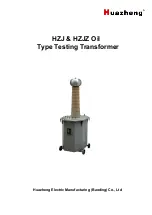
Page 84
gLOSSaRy OF TERMS, cOnTinUED....
Model Name:
The Model Name function allows you to name each of your individual models. This makes it easy to keep track of
multiple models. The Model Name can consist of up to 8 letters, numbers, or symbols. Choose from capital letters, lower case
letters, numbers, and various symbols.
Model Select:
The Model Select function allows you to load the programming for the particular model you wish to fly. The
Programming Data for all of your models is accessed through the Model Select menu.
Multi-Function LCD:
The heart of the programming and display features of the transmitter. All programming and transmitter
display functions are shown on the Multi-Function LCD.
Navigation Pad:
The Navigation Pad is used in conjunction with the Programming Keys to facilitate transmitter programming.
The Navigation Pad allows you to quickly and easily move the Programming Cursor up and down, and right and left. The ENTER
key in the center of the Navigation Pad is used to open the selected menu or programming option.
Neck Strap Anchor:
Used to attach your neck strap (available separately) to the transmitter.
Ni-MH:
Short for Nickel Metal Hydride, a Ni-MH battery typically has about two to three times the capacity of an equivalently sized
Ni-Cd (Nickel Cadmium) battery, therefore, they are ideal for use to power both the transmitter and the receiver.
Offset:
The Offset function allows you to shift and hold the neutral position of the Slave servo within a Compensation Mix.
Operating Voltage:
The safe voltage that the transmitter or receiver can operate within. Exceeding the minimum operating voltage
can result in loss of power to the device(s). Exceeding the maximum operating voltage can result in damage to the devices(s).
Output Power:
The power (in Milliwatts) that your transmitter transmits a signal. Output power is defined by government
guidelines and differs by region.
Pitch Curve:
The Pitch Curve function allows you to vary the amount of pitch travel in relation to the movement of the throttle
control stick at different points throughout the entire range of deflection.
Power Indicator:
Indicates that there is power to the transmitter. When the battery voltage drops to 6.7 volts, the audible Low
Voltage Alarm will sound.
Power Switch:
Turns the transmitter ON and OFF.
Programming Keys:
The Programming Keys are used to facilitate transmitter programming and select models stored in
memory. The four Programming Keys consist of the INC+/M1 (Increase/Model 1) key, the DEC-/M2 (Decrease/Model 2) key, the
END/M3 (End/Model 3) key, and the F-MODE (Flight Mode) key.
RF Output Indicator:
Illuminates when the transmitter is turned ON and transmitting a signal. If the RF Output Indicator fails
to illuminate, RF output is limited or non-existent. In this case, you should not fly. The RF Output Indicator will flash when the
transmitter Trainer mode is set to Slave.
Rudder Trim Switch:
Used to control
the Rudder axis Right and Left trim.
Servo Centering Sub-Trim:
The Servo Centering Sub-Trim function allows you to fine-tune the Center (Neutral) position of each
servo. It's not unusual that when you install the servo horn onto your servo that the servo horn is not perfectly centered. The
Servo Centering Sub-Trim function allows you to center the servo horn perfectly.
Servo Monitor:
The Servo Monitor displays the output levels of each of the 6 channels in bar graph form, allowing you to monitor
servo operation in a virtual manner. This is helpful to see servo movement when the control sticks and switches are moved, and
it allows you to visualize what is occurring with servo movements when you apply different mixing values. The Servo Monitor also
indicates which channel slots in the receiver to plug your servos into
Servo Reversing:
Electronically switches the direction of servo travel. For example, if you move the elevator control stick
forward, and the elevator moves up, you can use the Servo Reversing function to make the elevator move down.
Spoilerons:
Spoilerons is a mix of spoilers and ailerons, allowing you to use the ailerons as spoilers if your model does not
feature separate spoilers. When Activated, both ailerons are moved up at the same time to provide the function of spoilers, while
still providing aileron roll control.
Stopwatch Timer:
The Stop Watch timer is used to either count down from a programmed Start time (Count Down mode) or
to count up from zero if no Start time is programmed (Count Up mode). In Count Down mode, an audible tone will sound in 1
second intervals when the Stop Watch reaches 10 seconds from zero. When zero is reached, a long audible tone will sound and
the Stop Watch will begin to count up. In Count Up mode, an audible tone will sound at 1 minute intervals to remind you that the
count down time (zero) has been surpassed. One of its more popular uses is to use it as a fuel usage indicator to remind you to
land within an allotted amount of time to ensure that your model doesn't run out of fuel.
Swashplate:
The swashplate changes the pilot's linear cyclic (and often collective) control inputs into rotary blade pitch angle
changes in the main rotor. It is the position of the swashplate that determines which direction the rotor disk will move in.
REFEREncE
Summary of Contents for SD-6G
Page 1: ...Page 1...









































